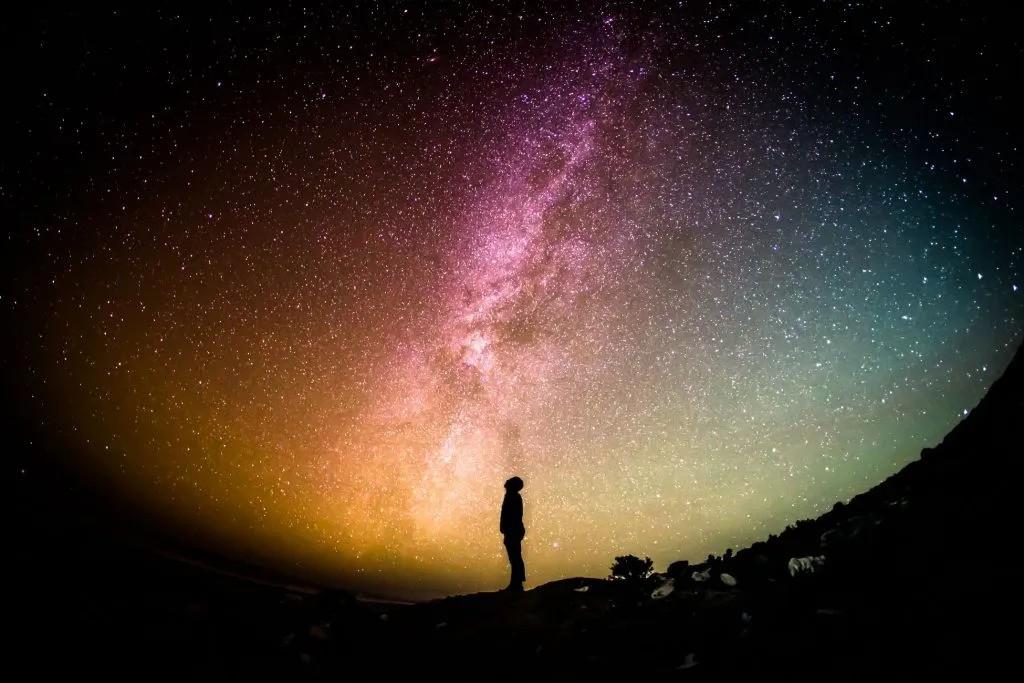What are the three circles?
In Lesson 1, we touched on the three circles and the connection they have with the different paths that people take. A further exploration of the three circles is required in order to give us a greater understanding of these different paths.
The three paths are:
- Exoteric (outer circle)
- Mesoteric (middle circle)
- Esoteric (inner circle)
These circles or paths that we choose to venture on during our lifetime are dependent on what is known as the centre of gravity. Our centre of gravity is determined by the aspect within us that we choose to function from.
When we speak about the human being as a unit, we come to discover that we are not unified within our internal constitution, but are made up of a mixture of divine and non-divine elements.
The divine that exists within us is a small fractured piece of divinity. This spark has been polarised through the law of vibratory affinity and through the unfoldment of creation has had to fracture itself. The vibration of the divine is incompatible with the denser expressions of creation and therefore has to fracture itself into smaller and smaller parts until creation reaches its densest form. Here, in the physical dimension, that small spark of divinity constitutes what we call the essence.
This essence (spark of divinity) is forgotten, lost, and transforms into the non-divine aspect we have within, known as the subconscious or ego.
The inherent nature of this divine spark is to act with positive values such as altruism, love, kindness, etc, but instead those values have been transformed into rudeness, hatred, coldness, etc… This is what is known as the subconscious or ego.
Sadly, in our everyday life we do not function from the sense of the conscious mind or divine spark, but rather from the subconscious. The subconscious dictates how we respond to the events of life, as well as how we view and perceive the world.
The subconscious mind typically refers to the part of our mind that lies just below the surface of conscious awareness. It consists of thoughts, feelings, memories and information that are not currently in our conscious awareness but can be readily accessed with focused attention or when triggered by certain stimuli.
Our perception of reality is interpreted by how we conceive and see reality. Often we interpret and see reality through the eyes of the subconscious. We see life through the lens of concepts and ideologies, each of which have attached to them a subconscious response, consisting of thinking, feeling and acting.
We find that when we engage and interact with someone it follows a pattern that we ourselves have pre-established. This pattern typically looks like:
Impression -> 5 senses -> concept -> memory -> past experience/association
The subconscious, in association with our neurological pathways, forms connections within our synapses that then lead to mechanical behaviour. We do not perceive impressions/events of life consciously and therefore we do not treat them as a distinct, isolated event. Instead, they touch our mind and engage the subconscious/unconscious and we respond using elements connected to the subconscious.
Not only do we respond mechanically to events within life, but the subconscious conditions our perception of reality.
What is the exoteric circle?
The exoteric (or ‘outer’) circle represents the first path that our essence attempts in order to find a sense of union once again. This is the path that seeks pleasure and fulfilment within the realm of matter.
The essence tries, through the experiences of life, to find and fill that sense of yearning. The sense of yearning that comes from the essence is transformed within the exoteric circle (within the sphere of life) and changes into desire.
The essence/consciousness within the sphere of the exoteric circle attempts to look for fulfilment through the desires that characterise the physical sphere:
- Money
- Sensorial pleasure
- Accomplishments (titles, recognitions, etc)
The consciousness creates these desires in the pursuit of fulfilling the void it feels, but is directed and focused within the sphere of matter.
Through the cycle of samsara (death and rebirth) we try a variety of experiences all characterised by desire. We believe that money will bring us a sense of fulfilment, so we dedicate our time and energy to the pursuit of wealth. Or, we feel that a big house will make us happy, so we dedicate our time and energy to servicing a hefty mortgage. Perhaps we wish to go on an expensive overseas holiday, so we dedicate our time and energy to planning, booking, organising, etc… Through all this, what a person comes to realise is that wealth/a big house/ a fancy holiday has not brought them happiness or a sense of fulfilment.
Once the desire is realised and the person is left unfulfilled, that experience may produce a realisation within the divine spark itself, a realisation that will set the divine spark on a journey to find a different way of doing things. This realisation comes to the essence in the form of consciousness, of conscious comprehension.
It is like when a child places their hand in a flame and burns their finger. That child learns through experience not to repeat that action, because it will result in pain. That realisation made by the essence travels from lifetime to lifetime and has the capacity to inform the essence about what experiences to look for and what experiences to avoid in the following existence.
Every experience that is encountered on the path of the exoteric circle has a role to play in moving the essence to find a different path.
Karma
As the essence travels from lifetime to lifetime trying different experiences within the realm of matter, it infringes upon the principle of equilibrium. By breaking the principle of equilibrium the essence incurs consequences, or ‘karma’.
Karma is cause and effect - we do good, we receive good; if we do bad, then we receive bad. If we cause someone pain and suffering, through the law of karma, at some point in one of our existences we will experience pain and suffering. This is done with the intent of producing an awakening within our own consciousness.
What happens as part of the exoteric path is that we as the essence continue committing mistakes which disrupt the balance of the law of equilibrium. This requires us to rectify that behaviour through experiencing that behaviour ourselves. If the essence is able to comprehend that the consequences it experiences are as a result of its own behaviour, then it has the ability to transcend the state of consciousness it finds itself in.
The law of karma in fact acts as a mirror, allowing us to encounter ourselves through the action that we receive i.e. being mistreated, being spoken to incorrectly, etc.
This should provide us with a moment of reflection to see and understand our own actions and the consequences they bring. However, most people do not assimilate the principle of karma in this way. Rather, someone yells at us, making us feel bad, and instead of using the moment to observe and understand this within us, we respond through mechanical reaction and yell back at them. In doing so we add more fuel to the fire and continue perpetuating karma, increasing the weight of that karmic exchange. This is how relationships crumble - one person says one thing, the other person fires back with a stronger retort, and it continues in this manner until there is a breakdown of communication. The only way to resolve that unbalance within the relationship is to undo the karmic knots that have been created. Only then can the issue be resolved, and the relationship mended.
So the principle of karma is intended to be a course correction, in the sense that if we cannot learn through the good ways, we must learn through other means.
What is inevitable in the exoteric circle is the accumulation of karma, and this inevitably leads us, as the essence, to a point of introspection.
Changing our reality
And so the pain and suffering has a purpose, providing the consciousness with an opportunity to move out of the exoteric circle and start to turn its direction from the external to the internal.
If we are functioning from the perspective of mechanicity, which comes from a state of being unconscious, then the consequences of our actions will generate unconscious results. These unconscious results feature an element of karma, keeping us trapped with the cycle of pain and suffering.
If, on the other hand, we are able to transform our subconscious into consciousness and act free of mechanicity, we will find that we slowly begin to break free from the cycle of samsara.
“Insanity is doing the same thing over and over, and expecting different results.” - Albert Einstein
If we continue to operate from the same level and state of consciousness, then we will continue to produce the same consequences for ourselves.
If we function by means of a mechanical state of consciousness, that is going to produce the same results, but for some reason we think that if we continue being the same person we have always been, it will somehow create different circumstances.
Or, perhaps we believe that we are not the problem, everyone else around us is. We see this in the example of an employee who moans and complains about their workplace. They blame everything around them - the boss, the colleagues, the clients, etc, until finally one day they leave. In the next workplace they find the same problems, the same difficulties, the same issues, because they did not recognise the part that they had to play in the scenario, instead only blaming others.
The only way we can truly change our external reality is by changing our internal reality, because the external is simply a result of the internal. If we carry disorder and disharmony within, we will find situations of disorder and disharmony around us.
We need to change our state of consciousness in order to change our external circumstances. If we can do this, we slowly but surely move to the path of the mesoteric (middle) circle.

